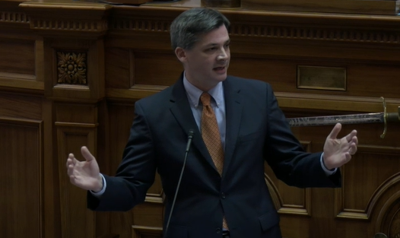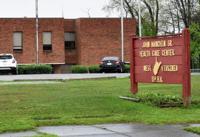
Sen. Shane Massey at the March 26 hearing
COLUMBIA, S.C. - South Carolina passed a groundbreaking tort reform law this year to help relieve an insurance crisis triggered by huge jury verdicts against bars and restaurants that served drunk drivers.
That crisis was caused, in part, by a 2005 tort reform law that carved out an exception for lawsuits based on “the use, sale, or possession of alcohol.” That exception made bars and restaurants liable for an entire verdict if a jury found them even 1% responsible for an accident.
The hospitality industry got its wish this year with a change that closed those rules for alcohol-related lawsuits. But with the new law, lawyers who dominate the South Carolina Legislature opened another loophole to protect a different line of business: asbestos lawsuits.
“I don’t like carveouts,” the reform bill’s sponsor, Sen. Shane Massey, said in a March 26 hearing. “I don’t like ‘em, but I recognize that’s where we are.”
The tort reform package was announced earlier this year to great fanfare at the statehouse in a press conference by Gov. Henry McMaster. But by that March 26, Massey was exasperated, even declaring he himself might not vote for his own bill.
Around a recess that night, amendments were made, including protections for asbestos lawyers.
How the asbestos exception slipped into a bill where Republicans control every branch of government explains a lot about the power of the trial bar in South Carolina. No detailed discussion of the carveout appears in the legislative record.
Sam Aaron, research director for the South Carolina Policy Council, described the legislative process as “quite opaque.”
“Rather than being debated openly on the floor, much of the negotiation took place behind closed doors, essentially in an executive session,” Aaron said.
”From what I’ve heard, legislators who work as both defense and plaintiff attorneys met privately to hash out the details of what the final bill would include.”
Senate Bill 244 was introduced on Jan. 16 and didn’t include an asbestos exception until that March 26 hearing, when Sen. Massey referred to days of backroom discussions over how to get the bill through legislative committees thick with plaintiff lawyers. There are around 40 lawyers in the legislature who do personal injury work or their firms do.
The 23-member Senate Judiciary Committee includes 12 attorneys, 10 of whom are personal-injury lawyers. Republican Speaker of the House G. Murrell Smith represents a court-appointed receiver who has pulled in tens of millions of dollars in settlements from the insurers of asbestos defendants.
He also plays a prominent role in selecting judges throughout the state. At least two other legislators work at firms with asbestos practices.
“I think a good analogy where we've been in this bill is like World War I trench warfare,” Sen. Chip Campsen III said at one point. “I mean, nobody's getting anywhere. No one's taking any ground.”
Business groups had a few key objectives when they pushed for tort reform this year. One was to protect the hospitality industry, where the alcohol carveout had led to huge verdicts in drunk-driving cases and skyrocketing insurance premiums.
A South Carolina Dept. of Insurance study found insurers reported losses of $1.77 per $1 of premium over the previous six years and bars and restaurants were having trouble getting coverage.
Legislators modified South Carolina’s tort laws in 2005 to bring them more in line with other states, including modifying joint and several liability so that defendants must be at least 50% responsible for a plaintiff’s injuries before they had to pay damages.
The alcohol carveout left bars and restaurants on the hook for the entire tab if they were only 1% responsible, however.
Another goal was allowing juries to consider other parties when apportioning fault, even if those parties weren’t being sued. Plaintiff lawyers like to structure their cases around the most solvent defendants and fight any attempt to identify other parties who might share blame.
The new law allows defendants to request those “nonparties” to be added to the jury verdict form, potentially reducing the percentage of liability of the named defendants. In exchange, once a nonparty is named, plaintiff lawyers have the option of adding it as a defendant.
Asbestos lawsuits typically name scores of defendants, however, each of whom are accused of selling products containing deadly asbestos fibers. Lately that includes Johnson & Johnson and anyone else that sold cosmetic talc, which plaintiff lawyers accuse of containing asbestos (J&J says that claim is false).
It seems it was a priority for plaintiff lawyers to keep the ability to sue many companies without all of them appearing on the final jury verdict form.
At the March 26 hearing, Massey said, "Here, there are things that I'm giving on that I don't wanna give on. i think the policy ought to be that you should be responsible for what you cause and I should be responsible for what I cause. It should not be the other way around."
After the Senate passed SB 244, it passed to the House where it died in committee. Legislators there crafted a similar bill, again with carveouts for asbestos and PFAS, another lucrative subject of mass-tort litigation.
Once again, the legislative record contains scant discussion of the carveouts. Rep. Weston Newton said “after working all last week, and all weekend,” lawmakers reached a compromise with the Senate bill and stuck it in a formerly unrelated bill.
The asbestos carveout means lawyers can continue the practice of naming 50 or more defendants and settle with most of them, without the jury learning the plaintiff blamed dozens of other companies for their illness – and may have collected millions of dollars in settlements already.
Asbestos litigation is a growing business in South Carolina, with a former chief justice of the state Supreme Court presiding over the docket. Judge Jean Toal has controversially allowed Columbia lawyer Peter Protopapas to take control of companies that mostly no longer exist in order to sue their former insurers over decades-old policies.
The result is confidential settlements whose funds go to secret Delaware funds designed to compensate victims, with Protopapas and other lawyers taking a big chunk for their work.
One such company, Cape Plc, still exists and has fought Protopapas' purported control over it. A United Kingdom court issued an injunction against the receiver, though it's unclear whether South Carolina courts will acknowledge it.
So how does the carveout apply? Take, for example, a $63 million verdict against Johnson & Johnson in a talc-asbestos case. J&J was one of only two companies left at trial after lawyers at Dean Omar sued nearly 50 companies on behalf of plaintiff Michael Perry.
Had it been allowed, J&J could have put the company that owned a worksite later condemned for asbestos on the verdict sheet to reduce its percentage of fault.
He had worked at an Embassy Suites that used a library for storage. It was condemned as being "full of asbestos" and workers were routinely digging it up by hitting the ceilings with furniture.
Perry said he went in the library around two or more times each month for long periods of time. But jurors were never able to hear this argument from J&J.
"The J&J defendants should have been allowed to fully present evidence of alternative sources of asbestos exposure other than cosmetic talc," the company wrote.








